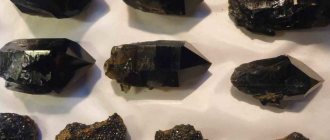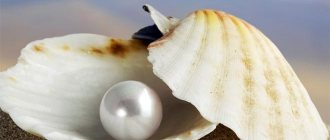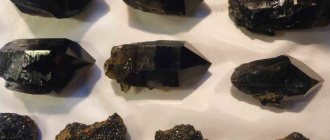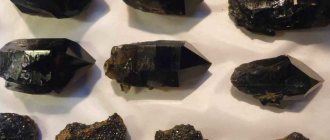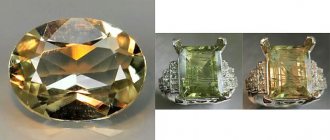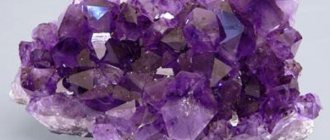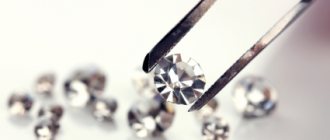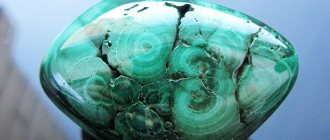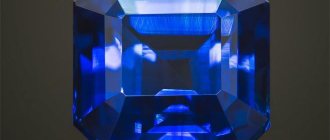Main varieties of corundum
Corundum is a type of mineral stone that is characterized by high hardness and a variety of shades. Thanks to these properties, it is used in jewelry.
The color of a stone depends on its chemical composition:
- Blue, also known as sapphire, contains titanium, vanadium and iron oxide.
- Red (ruby) – chrome, titanium, iron.
- Colorless (leucosapphire) – has no impurities and is therefore more often used in industry.
Some varieties of sapphire have a green tint. They are less attractive than emerald, so they are cheaper.
Sapphire - description of the stone
From the very first day of its discovery, sapphire attracted people with its high strength and beauty. He is called the king of stones, he often became an attribute of power and strength. Sapphires are mined in the following areas:
- Burma;
- Madagascar;
- Sri Lanka;
- USA;
- China;
- Vietnam;
- Thailand;
- India;
- Australia.
There are no industrial deposits on Russian territory. Sapphire is sometimes found on the Kola Peninsula (it has a cornflower blue color with a green tint) and the mines of the Urals (it has a gray tint).
Under the influence of high temperatures, sapphire loses its color, and under the influence of X-rays, on the contrary, its saturation increases. Sapphire can be:
- blue;
- black;
- green;
- yellow;
- white;
- pink;
- blue;
- violet;
- grey;
- pink-orange.
Traditional healers claim that wearing jewelry made from this stone, for example, a ring, helps in treating:
- asthma;
- heart disease;
- skin ailments;
- gynecological pathologies;
- migraine;
- mental disorders;
- kidney;
- diabetes mellitus
Sapphire is credited with various magical properties. The mineral is a talisman against the negative influence of others and helps the owner realize his creative potential. Sapphire is also indispensable for psychics; it is believed that it enhances clairvoyance abilities and helps communicate with the other world.
Earrings with sapphire will help a woman strengthen her love relationship, protect the family hearth, and make its wearer calmer and more decisive. For men, the crystal will help reveal their leadership qualities and mental abilities.
Sapphire is suitable for people born under the zodiac sign Sagittarius and Aquarius. The mineral will have a beneficial effect on them. However, it is contraindicated for those born under the sign of Capricorn, as it enhances their negative qualities. For other representatives of the zodiac circle, sapphire is considered neutral, but it can only be worn intermittently.
Ruby - description of the stone
Ruby has been known to man since the Bronze Age. In ancient India it was used to make talismans. Ruby is found on all continents except Antarctica. The most expensive minerals are those mined in Asia, usually stones from Thailand, Sri Lanka, and Myanmar. Rubies are also mined in Tajikistan and East Africa.
Rubies are not only red. Their palette is quite wide - from bright pinks to rich purples. Crystals of deep coral shades are considered the most valuable. In Ancient Rus' they were called red yachts, lalas.
Ruby has a number of useful properties:
- stops bleeding;
- improves intellectual abilities;
- normalizes blood pressure levels in case of hypotension;
- helps in treating ulcers;
- normalizes sleep;
- treats epilepsy, paralysis;
- improves psycho-emotional state;
- increases the tone of the body.
Water charged with ruby is also considered healing. It helps in the treatment of:
- bronchial asthma;
- diseases of the cardiovascular system;
- diseases of the eyes and ENT organs;
- general weakness.
Ruby is considered an ideal decoration for powerful, influential people. For an ordinary person, it brings good luck and restores vital energy. However, you need to take into account that wearing jewelry with red stone for a long time has a negative impact on your overall health. They are believed to drain energy from their owners.
There are many legends associated with ruby. In one of the ancient Indian parables they say that all the red crystals represent pieces of the soul of the devil, who was killed by the gods. He was too powerful and tried to take over the gods and the whole world, so they decided to kill him. The devil's body was broken into many small red pieces and scattered all over the world.
The red crystal gives its owner wisdom, strength and fearlessness. It brings good luck, happiness and prosperity to good people, but to evil people it only enhances their negative qualities.
Ruby is considered the ideal mineral for members of the Leo zodiac family. It enhances their leadership qualities, makes them decisive, courageous, and helps them unleash their creative potential. Ruby is contraindicated for Scorpios, Cancers, Virgos and Taurus. It is an ideal amulet for people working in areas of increased danger to life and health, for example, firefighters. Ruby protects its owner from injury, protects against the evil eye, and warns of impending danger.
MAGICAL PROPERTIES OF STONES (ruby, sapphire)
Paid surveys Miracle.money - AirDrop
Talismans
It allows the owner to be completely safe even among enemies, rewards with invulnerability, but for this the stone must be worn under clothing on the…
RUBY
Characteristic.
Ruby is one of the most expensive jewelry stones. It is a type of corundum, aluminum oxide. The color of the stone is associated with an admixture of chromium. In Rus', all red stones were called yakhonts.
Magical properties.
It allows the owner to be completely safe even among enemies, and rewards with invulnerability, but for this the stone must be worn under clothing on the body and it is advisable never to part with it. It controls love desires, settles disputes, protects against harmful magic, corrects bad moods, relieves grief and sadness. A stone of rich tones relieves nightmares. Ruby increases responsibility in a person and promotes leadership aspirations, relieving the owner of inferiority complexes and uncertainty. It gives birth to love and attraction to great things, be it science, art, military affairs, etc. It is generally said about ruby that it gives the strength of a lion, the fearlessness of an eagle and the wisdom of a snake. The stone can change color, which will serve as a warning to the owner of danger, but this ruby skill must be observed for a long time, if only because the color does not change too much. Ruby is the stone of those who want to achieve a lot in life, and it supports the owner in this if he does not have vain vanity and understands that great goals are goals of achieving happiness for other people. Ruby lives extremely reluctantly with usurpers and, as a rule, does not give them its energy. The ruby will try to de-energize a bad person and drain the energy out of him. It is best to purchase a stone on the thirteenth day of the moon.
Medicinal properties.
As a healer, ruby revitalizes strength, strengthens the heart, drives away pestilence, restores memory, normalizes blood pressure, heals flu, anemia, psoriasis, stroke; helps with epilepsy, stops bleeding, helps with wounds, brain diseases, diseases of the spine, bones and joints; protects against viral and other infections. The ancient healing books say that ruby is a panacea for all diseases, but it is used in different ways. Now ruby is in many ways indispensable for implantations. Its ability to accumulate, store and exchange information is especially used in diseases of the spine, urology, and dentistry. Ruby and its rays are very beneficial for the eyes, and ruby lasers are a means of treating the retina. The ruby ray activates the immune system and regenerates metabolic processes.
SAPPHIRE
Characteristic.
Corundum with impurities of titanium and iron. Star sapphire has inclusions of rutile, which forms a three- or six-rayed star.
Magical properties.
This talisman stone strengthens a person's informal power over other people, strengthens the spirit and is a stone of high-level teachers. Star sapphire is a talisman of faith, hope and love, giving a person wisdom in achieving his intended goal. Sapphire gives fidelity, chastity, attracts friends, gives birth to modesty and truthfulness, drives away enemies - both visible and invisible. All sapphire-level gemstones (diamonds, beryls, etc.) are dangerous due to their defects - cracks, spots, cloudy areas. And we must remember that the stones of good water, transparent,
without defects are extremely rare in stores. As an amulet and talisman, sapphire drives away fears, protects against slander, unjust courts, treachery and betrayal. In the East, sapphire was traditionally considered the petrified drink of the gods, bringing them immortality, and sapphire bowls improved, sometimes quite significantly, any content poured into them. The stone is a talisman for prisoners, helping them to free themselves and winning over the authorities to their side. In general, it helps to “open” any doors, including the doors of life advancement, that is, it opens a path for a person, offering many options for personal development. Sapphire softens the wrath of the gods and is one of their favorite offerings. The stone activates a person’s spirituality, provides inspiration and sharpens the perception of the world. It connects a person through communication with angelic beings with the entire cosmos, with the universe and leads to God. However, the stone is completely useless to egoists and dark personalities and will not work for such a usurper.
Medicinal properties.
As a healer, he treats epilepsy, eczema, strokes, neuroses, paralysis, diabetes, reduces warts, cleanses the genitourinary system, the uterus and puts the endocrine system in order. Sapphire also makes medications more energy-intensive, especially in the treatment of diseases of the skeletal system, and is indispensable as an implant in orthopedics and dentistry. Sapphire helps with itching, tumors of any origin, eye diseases (including getting rid of the “evil” eye), and improves digestion. He also heals wounds, even the most severe ones. A sapphire beam (whether a person looks at it or directs it to a specific diseased area) has a beneficial effect not only on the skin, but also on the organs located in a given place (like green beryl - emerald, like ruby). Sapphire radiation therapy normalizes the activity of all endocrine glands.
SARDONYX
Characteristic.
Belongs to the group of chalcedony. It is also called agate, but it must have straight parallel layers of alternating brown, white and blue colors.
Magical properties.
As a talisman, sardonyx makes a person courageous, fearless, and gives the opportunity to enter into a successful and happy marriage. It reveals to the wearer the secrets of any teachings and religions, makes hidden information accessible, and contributes to a scientific understanding of the world and its phenomena. Sardonyx can also become an excellent assistant in clairvoyance, when a person would like to look into the future. As an amulet, sardonyx provides protection while traveling, and many famous travelers carried it with them.
Medicinal properties.
For medicinal purposes, sardonyx is used when it is necessary to establish a person’s ability to regenerate (recovery): this stone helps internal organs and tissues begin to function properly again, that is, sardonyx actually helps to rejuvenate the human body. It perfectly relieves feverish conditions, accelerates the healing of broken bones, stops bleeding, helps to improve the functioning of the spleen (blood-forming organ) and the entire endocrine system of the body. Sardonyx heals the digestive organs.
SELENITE
Characteristic.
A type of gypsum with a silky sheen. Its color is yellowish. It was often considered a sacred stone. It also reacts to full moons, but the color almost always remains the same.
Magical properties.
An amulet for people who tend to develop their intuition: it does not allow them to fall into euphoria and pacifies their manifestations. Selenite perfectly combines all the protective qualities for women and, as a talisman, makes them insightful and mysterious. Selenite is the sacred stone of female priestesses; it protects fidelity and devotion, purity and immaculateness.
Medicinal properties.
As a healer, he perfectly heals the fluid, salt, and immune systems of the body, and also relieves headaches and toothaches, improves vision, heals the liver, gall bladder, and spleen. Selenite strengthens the will and mental abilities. She provides assistance to women with almost all diseases and strives to ensure that they never disturb their beloved mistress again.
ruby stone properties sapphire human sardonyx magical helps diseases quality color
| + |
What is more expensive - ruby or sapphire?
It is simply impossible to determine which stone will be more expensive. Each of the crystals has a different chemical structure, formula, weight, and shades. A stone with the same carat can have different values, which are influenced by different characteristics. The most expensive rubies are purple-red stones, and sapphires are bright blue with a white or blue star inside.
What to look for when buying a ruby
Ruby is very similar to other minerals, especially garnet, tourmaline, spinel and even glass. Today it is also produced artificially, so to purchase an original stone it is important to pay attention to some features.
- The natural mineral has a bright red glow, which is why it is also called fiery. Artificial stones are usually dull with a shallow shine.
- Experienced jewelers easily process rubies, giving them clear edges that do not have bulges or irregularities.
- When looking at a real ruby under a microscope, you can see small inclusions and other defects. Artificial stones do not have this - they are perfectly clean.
- Natural ruby is highly durable – it is extremely difficult to damage or scratch.
- Since ruby contains chromium, you can notice a purple tint in it. It will differ in its intensity, which depends on the percentage of chromium. Artificial rubies do not have this property.
- The natural mineral takes a very long time to heat up in your hands. If you take a ruby, and it immediately warms up from body temperature, then this means that this is a fake.
- Under ultraviolet rays, the fake takes on an orange tint.
- If you place a real ruby in milk, it should take on a pink tint.
- In real stone, any cracks are zigzag-shaped, while in artificial stones they are smooth and have a bright shine.
- The cross-section of a real ruby is distinguished by the structure of straight layers, while the fake has circular streaks.
Precious Brothers: Rubies and Sapphires
There are precious stones that are widely known, about which various stories, legends, myths are told... How much truth there is in them, and how much fiction - no one knows for sure. But an aura of romance and mystery accompanies them always and everywhere. Today we will talk about rubies and sapphires. In the East they are considered half-brothers: ruby is the son of the Sun, and sapphire is the son of Jupiter, but both of them were born of the Earth. These minerals are aluminum oxides, a type of common corundum.
Ruby is, along with sapphire and diamond, the most expensive of precious stones; the name of the stone comes from the Latin ruber - red. In Rus' it has long been called a yacht. The color of a ruby can be pink or fiery red, but the most valuable are red stones with a purple tint. Sometimes a mineral contains inclusions that increase its value - rutile needles. They give the stone a silky tint, and with certain processing, the ruby gives the effect of a cat's eye, or asterism.
An ancient Indian legend says: “The bright sun of the South carries the living juices of the great Asura, from which stones are born. The eternal rival of the gods, the King of Lanka, attacks them like a hurricane... Stones of heavy blood fall onto the bosom of the river, into the deep waters and into the reflection of beautiful palm trees. And from then on the river was called Ravanaganga, and from then on these drops of blood, turned into ruby stones, caught fire, and they burned with the onset of darkness with a fabulous fire burning inside, and pierced the water with these fiery rays, like rays of gold ... "Ruby and sapphire were favorite stones of Tsar Ivan the Terrible. He always carried a ruby with him and said that “... this yacht heals the heart, brain, strength and memory...”.
Large rubies, like diamonds, are surrounded by great honors - they are inserted into crowns, stored in treasuries and exhibited in famous museums. In the crown of the Shah of Persia, for example, there is a ruby the size of a hen's egg, and a beautiful, densely colored translucent ruby crystal weighing 167 carats - the "Edward Ruby" - is the pride of the British Museum of Natural History.
The largest known ruby, the Raja Ratna, the King of Gems, weighs 459 g (2475 carats) and belongs to the modest Indian lawyer J. Vijaya Raja, who inherited it. And a huge ruby cabochon measuring 7.94x6.35x3.81 mm and weighing about 1795 carats (359 g!) is in a private collection in the USA along with a sapphire weighing 5600 carats!
One of the most beautiful rubies in the world weighing 250 carats from the crown of St. Wenceslas is kept in the Prague Cathedral. This is an irregularly shaped stone measuring 3.95 x 3.65 x 1.4 cm and weighing about 250 carats. Prince Wenceslas I is the most revered patron saint of the Czech lands by the Czechs. According to legend, the German king, seeing Prince Wenceslas wearing a crown with this stone at the head of the Czech army before the battle, dismounted from his horse and submitted to him. Wenceslas was surprised why he was surrendering without a fight, and the German king replied: “How can I fight with you if there are two angels in such magnificent armor behind you?” Another legend says that whoever wears the crown of St. Vaclav, or even just trying it on, without having any rights to do so, will be cursed and will soon die. The curse of the Czech kings overtook the Reich Commissioner of German-occupied Bohemia, Heydrich. In 1942, out of vanity, he tried on the crown and a few days later was killed by Czech patriots. Although, maybe this is just a coincidence.
A deep cherry-colored star ruby cut into an oval cabochon measuring 3.15 x 2.65 x 1.91 cm and weighing 136.72 carats, found in Sri Lanka, is kept at the Smithsonian Institution in Washington. It is named after the donor - “Rosser Reeves”. Large rubies with carved images are known: “Liberty” (14x9 cm), “Mercy” (14x8 cm) and “Good Samaritan” (16x3 cm). The latter depicts a scene from the biblical parable that gives the stone its name.
Sapphire is the closest relative of ruby. This mineral received its name due to its bright blue color (safaros - blue), but it is surprising that modern experts call corundums of all colors of the rainbow sapphires, except for crimson-red (ruby, that is, ruby)!
The early Christian Church considered sapphire an excellent stone for decorating the rings of high priests: “...The bishop's ring should be made of pure gold and set with an uncut sapphire, since this stone has all the qualities necessary for such an honorable place, and can be a symbol of the rank of the Pontiff and the Seal of the sacraments... “- this is the decree of Pope Innocent III.
In the “Revelations” of John the Theologian, sapphire marks the twelfth step of the pyramid leading to the heavenly city of Jerusalem, and Pavel Florensky believed that in sapphire “... the long-awaited symbol of the soul rushing into eternity...”. Tsar Ivan the Terrible said: “...I love sapphire extremely. It preserves and increases courage, gladdens the heart, delights all the senses, is pleasing to the eyes, improves vision, heals bloodshot eyes and strengthens muscles and tendons..."
Large sapphires are rare and, like diamonds, they are given their own names. For example, the Star of India, a 536-carat star sapphire, is kept in the Natural History Museum in New York. This is the largest of the processed stones. The unique black sapphire “Midnight Star” weighing 116 carats is also stored there. The 330-carat Star of Asia sapphire is on display at the Smithsonian University in Washington, while the St. Edward and Stuart sapphires adorn the British Crown.
Two sapphires are kept in Paris - the Rospoli, weighing 135 carats, and a rough sapphire measuring 5x4 cm. The famous Rospoli was found in Bengal by a traveling seller of wooden spoons and then, in the 17th century, became the property of the Italian aristocrat Francesco Maria Rospoli. Through a chain of new owners, the sapphire came to the French jewelry merchant Pere, who in 1691 sold the stone to Louis XIV. After the French Revolution, the Rospoli sapphire was transferred to the Natural History Museum. Today you can see this stone in the museum building, which is located on the territory of the Paris Botanical Garden near the Seine embankment, between Cuvier and Buffon streets.
The largest orange sapphire (padparadscha, a very rare variety of sapphires, translated as “lotus flower”) is kept in a private collection in the UK, weighing 57 carats. In the Diamond Fund of Russia, a large sapphire (weighing 200 cards) is mounted in the cross of the power of the Russian Empire, and another, weighing 258 carats, is mounted in a brooch.
There is a legend about the magical healing properties of a sapphire ring that belonged to the English king Edward the Confessor.
King Edward, surrounded by his retinue, was traveling to Westminster Abbey and met a beggar begging in the name of St. John. The king took a ring with a large sapphire from his finger and gave it to a ragamuffin in rags. All subsequent years passed for the king in peace and tranquility, but suddenly arriving pilgrims from Jerusalem told the king that they were instructed to return the ring to him and tell him that the beggar would soon meet the king in paradise. The king understood that he was predicted to die soon, which soon happened. Two centuries after King Edward's death, his coffin was opened and his body was found to be completely intact.
The ring was exhibited in Westminster Abbey, where it was treated with the greatest honor. It was believed that anyone who touched it could be cured of paralysis or epilepsy and restore damaged vision. The St Edward's sapphire now adorns the crown of the British Empire, sitting in the center of the diamond cross.
source: njt.ru
